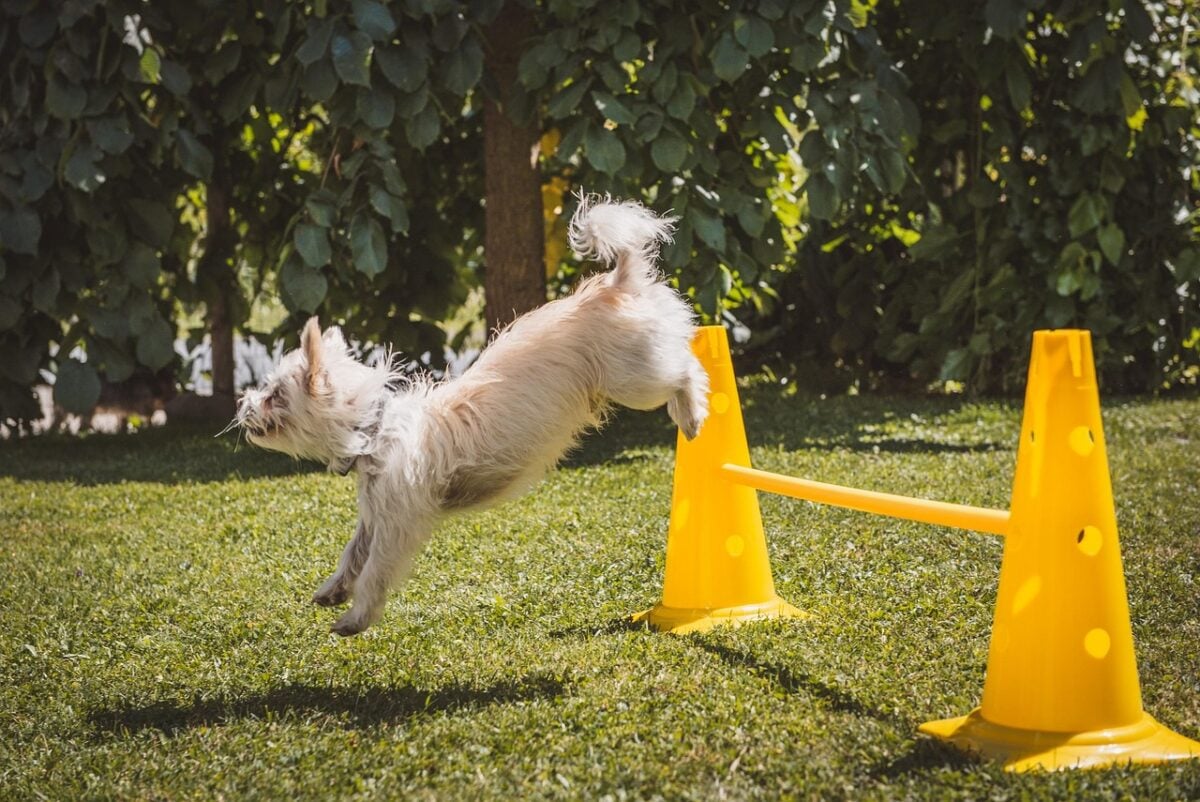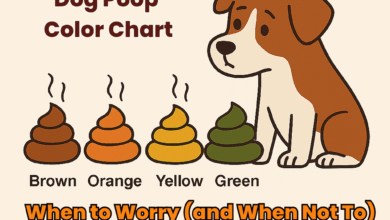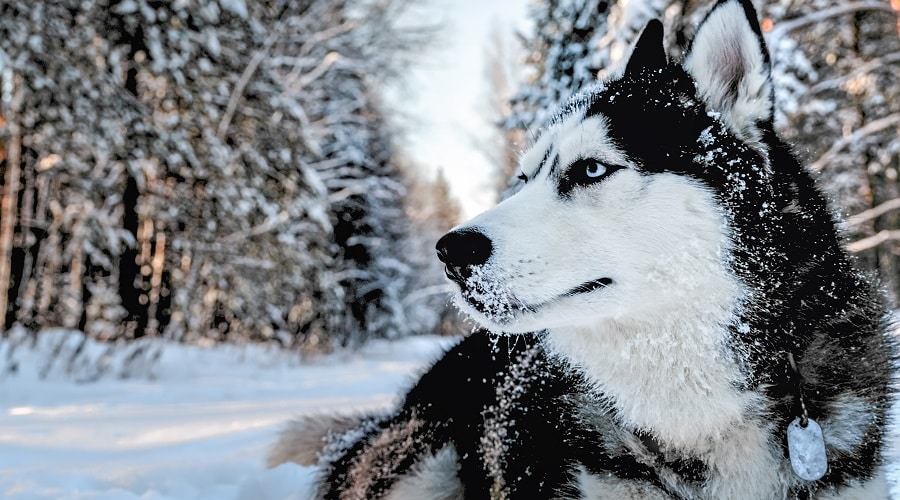When you purchase through links on our site, we may earn a commission. Here’s how it works.
Most dog parent think their pup needs longer walks. In reality, the secret to calm, happy dogs is working their brain, not their legs.
Table of Contents
When dogs get bored, they find their own fun: barking at nothing, digging the yard, chewing the couch. It’s not bad behavior — it’s pent-up mental energy.
The good news? You can tire them out with games that work their minds as much as their bodies. Each takes just minutes to set up and can transform your dog’s day (and yours).
Why Dogs Need Brain Training
Dogs were bred for jobs: retrieving, tracking, herding, guarding. Today, most don’t get to use those instincts. Mental exercise fills that gap.

Think of it like this: a 15-minute puzzle session can drain as much energy as a 30-minute walk. Mental work also reduces anxiety, boosts focus, and builds a stronger bond with you.
Training and play that challenge your dog’s brain don’t just make them smarter but also more relaxed and better behaved.
10 DIY Brain Games For Dogs
When your dog’s energy turns into chaos, it’s not because they’re bad — they’re bored.
These quick, at-home brain games use ordinary items to help your pup burn energy, focus better, and stay calm without another walk around the block.
1. Food Puzzle
This DIY classic takes under five minutes to set up. Use a muffin tin or egg carton, fill the cups with kibble, and cover with toys, tennis balls, paper, or cups.
Your dog has to sniff and move each cover to find the food. Switch up what you hide inside to keep the challenge fresh every time.
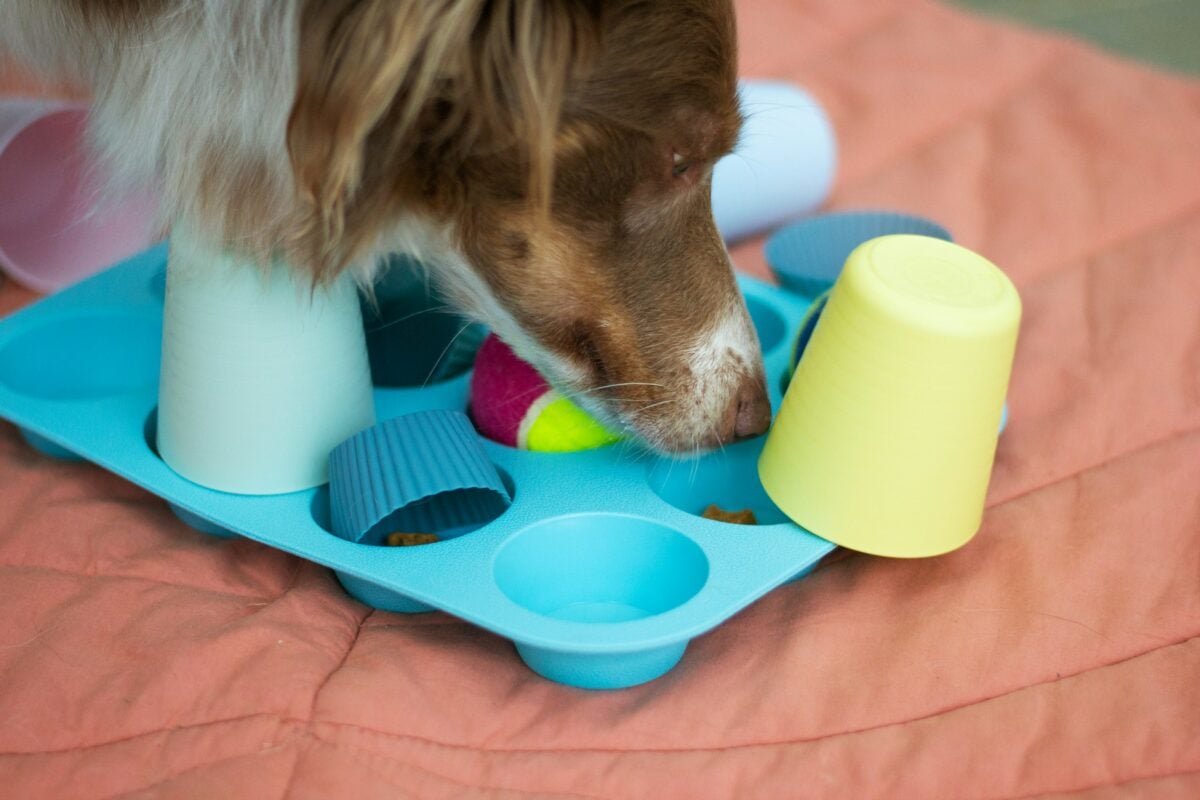
Try This Tonight: Freeze a few bits of kibble in water or broth for a cooling twist on hot days.
2. The Cup Game
You only need three plastic cups and a treat to turn this into a brain workout. Line up the cups, hide the treat under one, and shuffle them while your dog watches.
Encourage your dog to sniff and tap to find the right one. Start slow, then add speed or extra cups as they improve.
Trainer’s Note: Dogs love predictability — vary your shuffle to keep their focus sharp.
3. Hide-and-Seek
You’ve played this as a kid, but your dog will love it just as much. Have your dog sit and stay while you hide somewhere in the house.
Call their name once and wait for them to find you. It’s a simple way to build recall skills and strengthen your bond.
Buyer’s Guide: For a different version of hide-and-seek, try out this Outward Hound Hide-A-Squirrel dog toy. You hide the plush squirrels in the trunk, and your dog is challenged to nuzzle them out. The squirrels have hidden squeakers for added fun.
Our Personal Experience With Outward Hound Hide-A-Squirrel Dog Toy
This is my dog Daisy’s favorite toy. She has had several of these and will take care of the little squirrels for months. Eventually, she tears them up, and we get a new one.
This is a perfect toy for her because she loves hiding things and then finding them. We will hide the squirrels themselves all over the yard, and she will search them out.
– Danielle DeGroot, Dog Parent & Canine Journal Writer
4. The Scent Trail Challenge
Dogs experience the world through scent, so this one’s an instant hit.
Rub a treat or toy along the floor to create a short scent trail, then hide it out of sight. Encourage your dog to follow their nose to the prize.
As they get better, make the trail longer, add turns, or move it outdoors. Scent work tires dogs mentally and fulfills deep instincts, especially in hounds and retrievers.
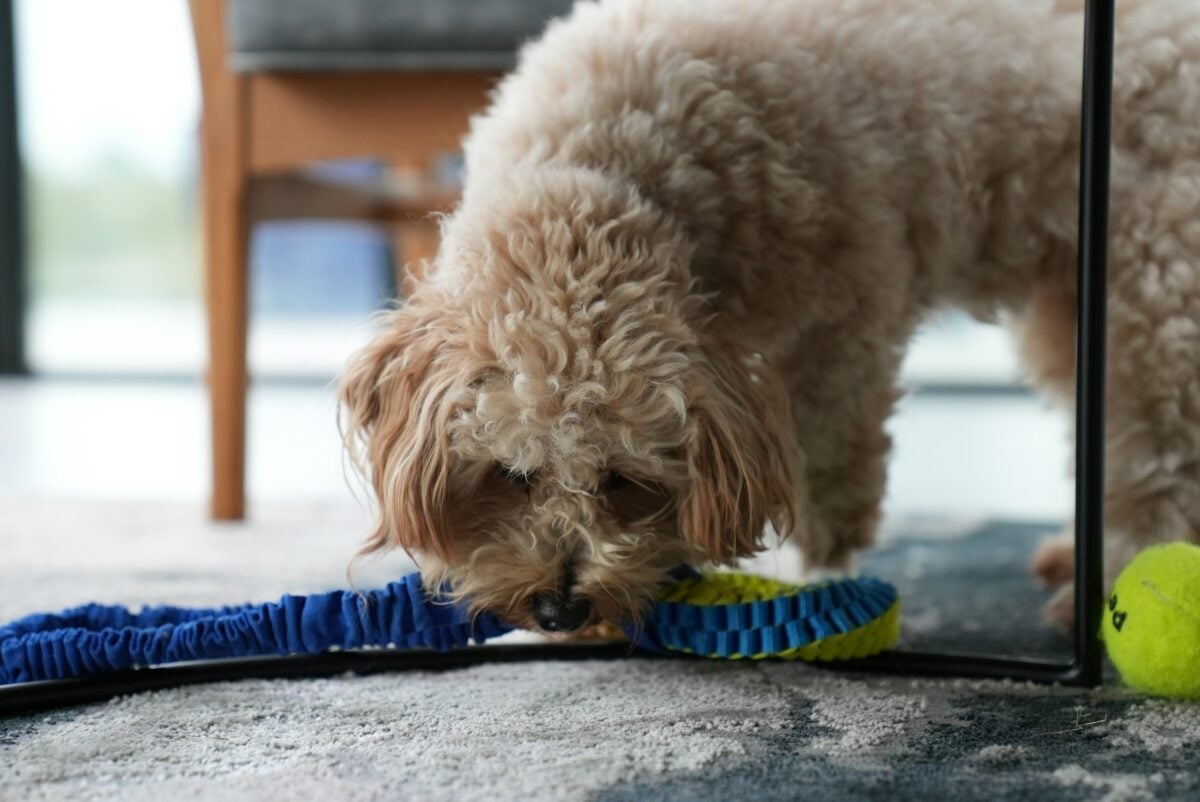
5. The Name Game
Think your dog only knows “walk” and “treat”? They can learn a lot more.
Start with one favorite toy, repeat its name several times, and then ask your dog to find it.
Reward them when they bring it back — that’s how they learn to associate the word. Over time, dogs can recognize dozens of items by name and love showing off what they’ve learned.

Quick Tip: Keep training sessions under five minutes so your dog doesn’t lose interest.
6. Lick Treat Challenge (Frozen Or Sticky Fun)
This one calms even the busiest dogs. Spread peanut butter, yogurt, or mashed banana on a flat plate or bowl.
Your dog will spend minutes licking, which releases endorphins and lowers stress. For a tougher challenge, freeze it first for longer-lasting fun.
Variation: Freeze low-sodium broth or a mix of yogurt and fruit into an ice block. Dogs enjoy licking, and it keeps them cool and engaged.
7. Treat-Dispensing Toys (DIY Version)
You can make your own treat puzzle in seconds. Cut a few small holes into an empty water bottle or plastic jar, fill it with kibble, and let your dog roll or nudge it around to release the food.
It encourages problem-solving and burns energy while they work for their reward. Switch up the container’s size and hole placement for extra challenge.
Why It Works: Dogs need to earn their treats — it satisfies instinct and builds confidence.
8. Sensory Box
Fill a shallow bin with safe, everyday items like tennis balls, small towels, and squeaky toys.
Hide treats inside and encourage your dog to explore with nose and paws.
The mix of textures, sounds, and smells gives them a full sensory experience. Rotate the contents every week to keep the game new and exciting.
Pro Tip: Add crumpled paper or fabric scraps for an extra digging challenge.
9. The Cleanup Game
This is part obedience, part genius hack. Teach your dog to pick up toys and drop them in a bin. Use cues like “get it,” “hold,” and “drop it” consistently.
It takes patience at first, but once your dog learns, it becomes a game they look forward to. You get help cleaning up and your dog gets to show off.
Try This Tonight: Use a shallow box or laundry basket for easy success.
10. DIY Obstacle Course
Turn your living room or yard into an agility course. Chairs become tunnels, broomsticks become jumps, and blankets form crawl spaces.
Guide your dog through with treats or toys. It builds coordination, confidence, and strengthens your teamwork.
DIY Ramp or See-Saw: Place a sturdy board on a rolled-up towel or low object. Encourage your dog to walk over it while it shifts slightly. It builds balance and curiosity.
The Rotation Routine (Weekly Brain Workout Plan)
Instead of playing the same game every day, rotate them to keep your dog mentally sharp. A balanced schedule keeps their brain active and prevents boredom from setting in.
| Day | Game | Focus Area | Duration |
|---|---|---|---|
| Monday | Food Puzzle | Patience and scent work | 15 min |
| Tuesday | Cup Game | Focus and confidence | 10 min |
| Wednesday | Hide-and-Seek | Recall and bonding | 20 min |
| Thursday | Lick Treat Challenge | Calm and focus | 20 min |
| Friday | Obstacle Course | Agility and coordination | 20 min |
| Saturday | Scent Trail Challenge | Nose work and confidence | 15 min |
| Sunday | Cleanup Game | Obedience and routine | 10 min |
A simple rotation plan keeps dogs engaged and gives you easy variety. Short, consistent sessions build stronger habits and lead to calmer, happier behavior overall.
Brain Games For Dogs That Can Be Purchased (No Time For DIY? Try These!)
If you’re short on time or your dog’s already mastered the homemade games, these ready-made brain boosters will keep them entertained with almost no setup. Each one is designed to challenge their focus, patience, and instincts, while giving you a few minutes of peace.
1. Puzzle Feeders
Puzzle feeders turn mealtime into a brain workout. Your dog has to move flaps, slide panels, or lift pieces to uncover hidden treats, which slows eating and builds problem-solving skills.
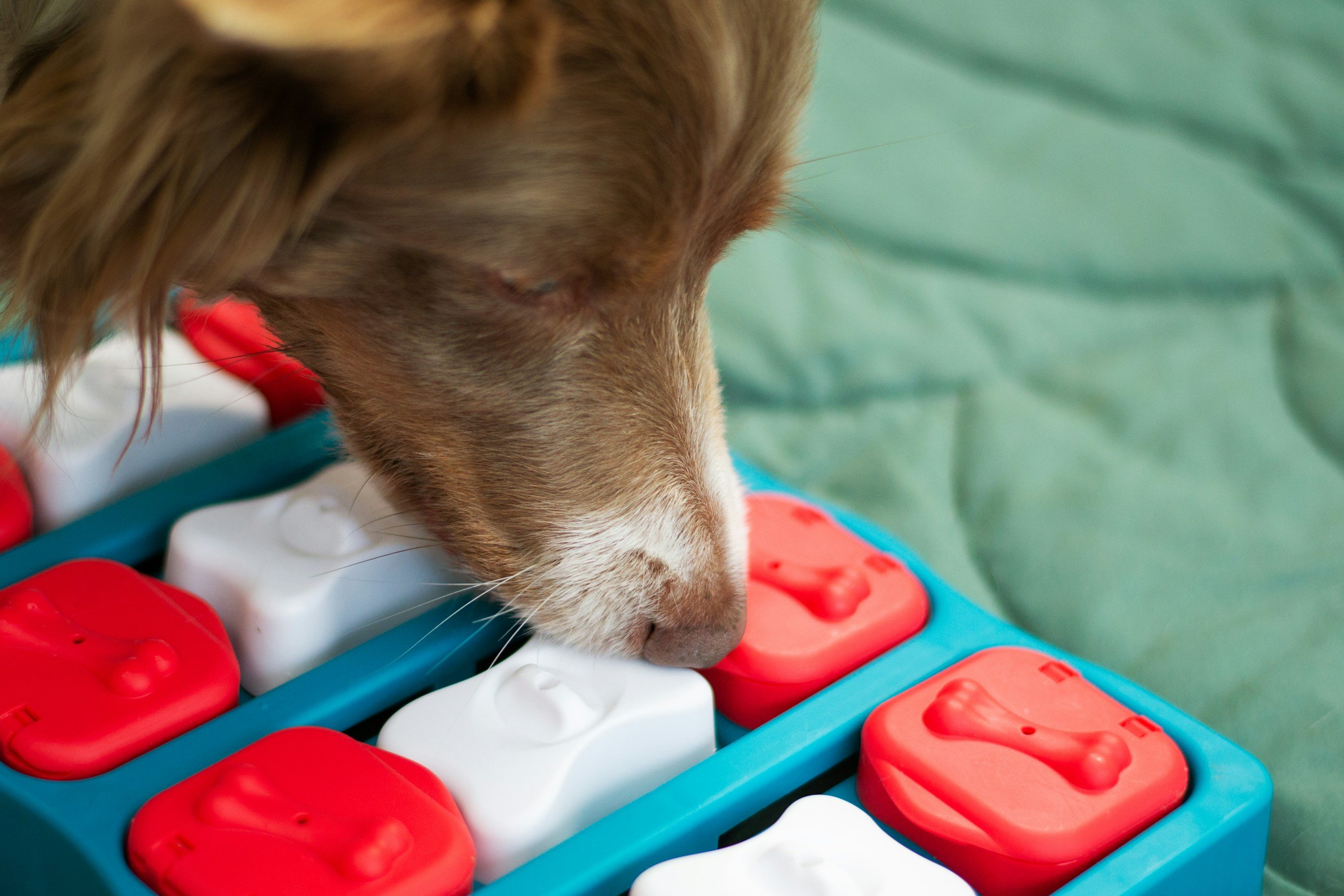
If your dog’s new to puzzles, start with something simple to keep them confident. Once they’ve mastered the basics, move on to more complex designs that test their patience and logic.
Easy Starter Options
- Outward Hound Puppy Smart Dog Toy – simple compartments to lift with the nose or paw.
- Ethical Pet Seek-A-Treat Shuffle Bone Puzzle – basic sliding covers that reveal hidden kibble.
More Challenging Options
- Outward Hound Dog Brick Puzzle Toy – requires multiple actions (slide, lift, flip).
- Trixie Pet Products Flip Board – combines knobs, flaps, and lids for advanced sniffers.
- Nina Ottosson Dog Casino Puzzle – interactive drawers with bone-shaped locks.
Why It Works: Dogs crave challenge, and these puzzles reward patience, persistence, and curiosity all at once. Start with easy puzzles and gradually move to more advanced ones as your dog learns how they work.
2. Treat-Dispensing Toys
If your dog needs a solo activity, treat balls or wobblers are a great choice. These toys reward every nudge and roll with a piece of kibble.

Some of our favorites include:
- OurPets Smarter Toys IQ Treat Ball
- Starmark Treat-Dispensing Bob-A-Lot
- West Paw Zogoflex Toppl Tough Treat-Dispensing Dog Chew Toy
They help burn energy and keep dogs mentally stimulated even when you’re not around. Adjust the difficulty as your dog gets better at solving it for hours of quiet play.
Why It Works: The combination of motion, sound, and reward taps into a dog’s natural prey drive.
Our Personal Experience With OurPets IQ Treat Ball
This toy keeps our puppy occupied for hours. And, when Barley stops playing with it, he falls asleep!
It is also impossible for him to chew, which means this toy will thankfully last much longer than most in our home.
– Michelle Schenker, Rescue Pup Parent and Canine Journal Co-Founder
3. Kong Classics
The Kong is a staple for a reason. You can stuff it with peanut butter, banana, or even a mix of treats and freeze it overnight.
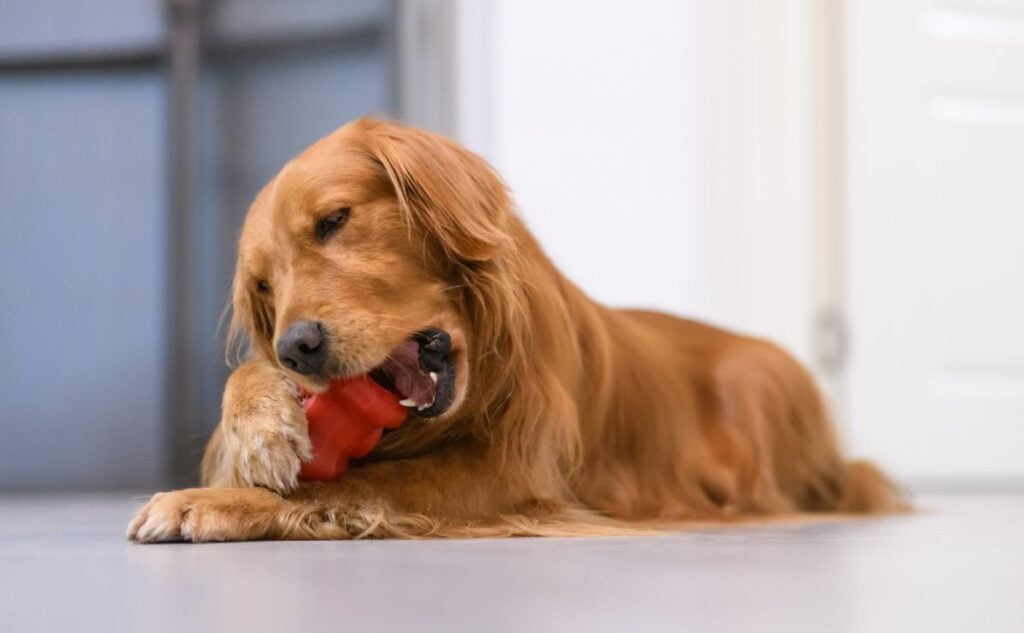
It keeps dogs calm and focused for long stretches, especially great for crate time or when you’re away. Kongs also satisfy the urge to chew, helping save your furniture in the process.
Trainer’s Note: For extra enrichment, hide two Kongs in different spots so your dog gets a built-in scavenger hunt.
Our Personal Experience With Kong Dog Toys
I have used the classic Kong chew toys with my dogs for over 20 years. These toys are fantastic for super chewers.
I have always had large dogs, Labrador mixes, who love to chew. These keep them entertained for hours on end and last for a very long time.
They have literally saved my furniture from getting destroyed, and my dogs love them.
– Danielle DeGroot, Dog Parent & Canine Journal Writer
4. Snuffle Mats
Snuffle mats turn sniffing into a game of discovery. They’re made of soft fabric strips that hide bits of kibble or treats, encouraging your dog to use their nose and instincts.
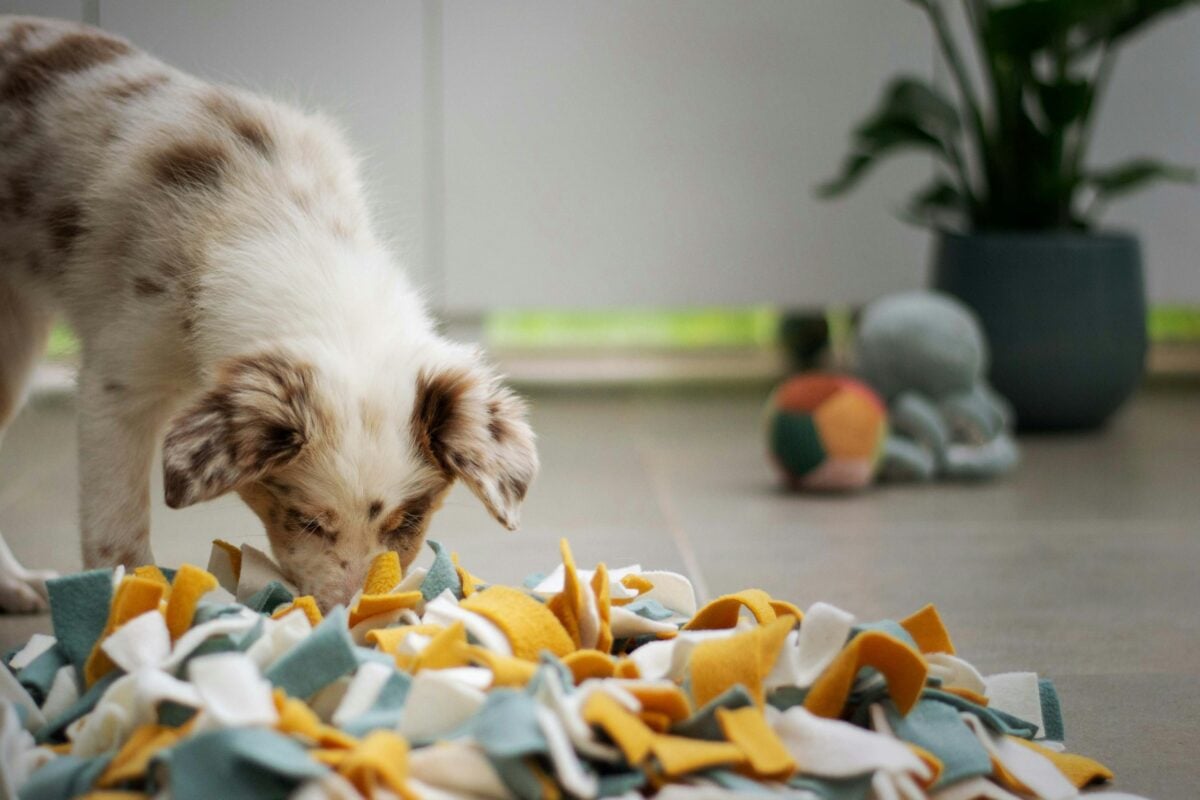
Dogs love the scent-based challenge and often relax afterward. They’re especially good for anxious or easily overstimulated pups.
View our picks for best snuffle mats for dogs.
Why It Works: Sniffing releases dopamine — the “feel-good” chemical — making it one of the calmest brain workouts you can offer.
5. Lick Mats
If your dog loves the Lick Treat Challenge, this is the next step. Lick mats like the LickiMat Soother let you spread peanut butter or yogurt in textured grooves for a relaxing activity.
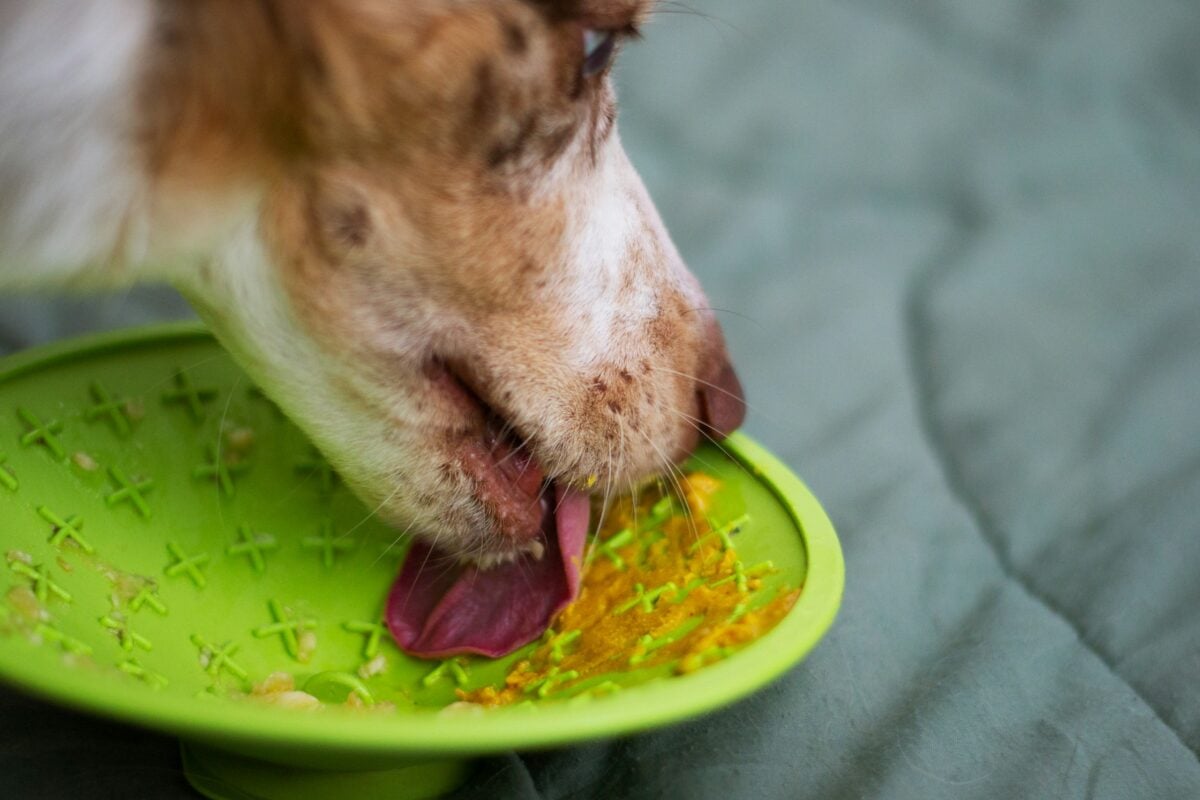
Licking soothes dogs and keeps them busy for long stretches. They’re perfect for grooming, bath time, or when you need them to stay calm.
View our picks for best lick mats for dogs.
Pro Tip: Freeze the spread for extra difficulty and a longer-lasting reward.
6. Beginner Agility Kits
Agility isn’t just for competitions — it’s one of the best full-body brain workouts. You can set up a simple course in your yard or living room with just a few starter pieces.
These kits build focus, confidence, and coordination, all while strengthening the bond between you and your dog.
Easier Starter Options
- Outward Hound Zip & Zoom Agility Kit – lightweight, quick to set up indoors.
- CHEERING PET Dog Agility Equipment Set – full outdoor kit that’s perfect for beginners.
More Challenging Setup
- FetchFlow Dog Agility Training Equipment – sturdier materials and additional equipment for more advanced training.
Guide your dog through each obstacle slowly at first, using treats or toys to keep them motivated.
As they get more confident, you can rearrange the course or time their runs for an extra mental challenge.
Why It Works: Combining physical activity with focus-based training keeps dogs balanced, fulfilled, and pleasantly tired — the perfect recipe for good behavior.
7. Communication Buttons: Can Dogs Really “Talk”?
Yes, and button training is where it starts. Products like FluentPet or Hunger For Words let dogs press buttons that play pre-recorded words such as “outside,” “play,” or “treat.”
Start with one or two buttons linked to your dog’s favorite activities and reward every successful press.
Even if your dog never forms full sentences, button training builds awareness, confidence, and trust.
It’s one of the most fascinating new enrichment trends for dog parents who love to communicate with their pets.
View our picks for best dog communication buttons.
Clicker Training: Building Focus & Communication
Brain games strengthen your dog’s mind, but clicker training takes that focus to the next level.
It’s one of the simplest ways to teach new behaviors and sharpen your dog’s problem-solving skills — all while deepening your bond.
A clicker marks the exact moment your dog does something right. The sound tells them, “Yes, that’s it!” and is always followed by a reward. Over time, your dog connects the click with success, and learning becomes faster and more fun.
You can use clicker training to reinforce recall, manners, tricks, or even parts of the brain games above. It turns training into a clear conversation — one where your dog always knows what earns praise.
Trainer’s Note: Consistency is everything. Click the same way every time and follow each click with a small treat, even if it’s just a bit of kibble.
Frequently Asked Questions
Keeping your dog’s mind active raises plenty of questions, especially if you’re new to enrichment play.
Below are answers to the most common questions dog parents ask about brain games, training frequency, and age-appropriate challenges.
Don’t see your question? Ask us in the comments!
How Often Should I Play Brain Games With My Dog?
Most dogs benefit from 10–20 minutes of mental work each day. Consistency is better than duration—short sessions every day are more effective than long ones once a week.
Can Brain Games Replace Walks?
Not entirely. Dogs still need physical exercise, but mental games can reduce excess energy and improve focus, especially on rainy or busy days.
What Are The Best Brain Games For Puppies?
Start with simple puzzles like the muffin tin or cup game. Puppies love exploring scent and sound, so keep it light and fun.
Do Senior Dogs Enjoy These Games?
Absolutely. Senior dogs often thrive on mental challenges. Use lower-impact options like scent trails, frozen treats, or name games to keep them engaged without overexertion.
How Do I Know If My Dog Is Bored?
Signs include pacing, whining, barking at nothing, or chewing furniture. Mental stimulation through games like these can quickly reduce those behaviors.
Don’t Forget To Stock Up On Dog Treats
You want to make sure you have plenty of dog treats when you’re training your dog or using some of these brain game ideas. Dogs are motivated by these tasty rewards, but not all treats are the healthiest options.
You may want to consider vegan dog treats or calming treats if you have a highly ergetic pup. See the best treats to reward your dog for some of our top recommendations.
